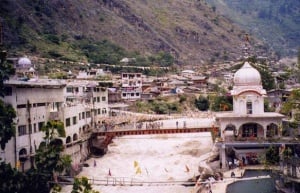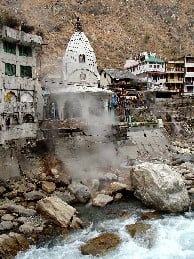Gurudwara Manikaran Sahib: Difference between revisions
No edit summary |
m (Manikaran moved to Gurudwara Manikaran Sahib) |
(No difference)
| |
Revision as of 15:01, 14 July 2007
Location : 45 kms from Kullu, Himachal Pradesh Famous For : Sikh Pilgrimage, Hot Springs Houses : Gurudwara & Springs
Perched on the right bank of the roaring Parvati River, Manikaran is situated at an altitude of 1760 m and is located at a distance of about 45 kms, from Kullu, via Bhuntar, in Kullu District of Himachal Pradesh. Manikaran, a place of pilgrimage for Hindus and Sikhs, has many temples and a gurudwara. It epitomize historic temples of Lord Rama, Krishna, Vishnu (Raghunath) and goddess Bhagwati. Ram Temple was built in pyramidal style by Raja Jagat Singh in the 17th century when the idol of Lord Rama was brought from Ayodhya. The idol was later shifted to Kullu. The temple was renovated by Raja Dilip Singh in 1889 AD. A trust is looking after the temple since 1981. The temple complex has three halls and forty rooms for the devotees to stay. A 'Lungar' (free communal food) is also served here.
SIKH HISTORY
Sri Guru Nanak Dev ji was with his Sikhs in the Himalaya mountains of India. His sikhs were hungry and there was no food. Guru Nanak sent his Good Friend Bhai Mardana to collect food for langar (the sikh's meal). Many people donated rice and flour(atta)to make parsadas(bread). The one problem was that there was no fire to cook the food. Guru Nanak than lifed a rock and a hot spring(hot water) appeared. The sikhs were able to make rice and beans. Bhai Mardana was having trouble making parasadas because they kept sinking. Bhai Mardana said I am going to donate my life in the name of God. The parsada amazingly floated. Guru Nanak Dev Ji said that anyone who donates his life in the name of God,All his(or her)drowned items float. This was a miracle. Sri Guru Nanak Dev Ji Gurudwara: The place is also held sacred by the Sikhs. The Janam Sakhi or the 'Twarikh Guru Khalsa' by Giani Gian Singh mentions about the visit of Guru Nanak Dev to this place. It has been mentioned that accompanied by his disciple Bhai Mardana, the Guru reached Jwalamukhi temple after visiting Kalanaur, Gurdaspur, Dasuya, Triloknath, Palampur and Kangra. The Guru then proceeded towards Mandi and after visiting Chamba and Kulu, he came to Bijli Mahadev. After preaching at all these places Guru Nanak Dev came to Mani Karan. The Janam Sakhi or the "Autobiography of Bhai Mardana" mentions the miracles did by the Guru.
Manikaran in Himachal Pradesh, situated at 1737m, on the banks of Parvati river is known for its curing waters. The place famous for its hot boiling sulphur springs is revered by lakhs who come here for a dip in the curing waters. It is believed that the hot springs can cure skin diseases like gout.
A huge gurdwara has been erected in the memory of Guru Nanak who is believed to have visited this place. A number of Sikh and Hindu pilgrims visit the gurdwara every year. A Ram Temple, built in the 16th century, is also situated near the gurdwara.
Manikaran is located 35 km from Bhuntar, near Kulu. Legend has it that once Lord Shiva and his divine consort Parvati were wandering in this sublime environment. Shiva liked the place and started meditating. Meanwhile, Parvati started taking a bath in the blue waters. While she was playing in the water she lost her earring. Shiva was enraged when he could not get back the earring, he started doing Tandav, the dance of destruction. The atmosphere got tense and Shiva threatened the serpent, the probable thief. The serpent fished the jewel out from the waters. Thus the river came to be known as Parvati and the place was called Mani(ring)Karan(ear).
The village 'shatt' is on the way where once a cloudburst had turned the village into a nullah. An awe-inspiring experiment at Manikaran is that of cooking rice or dal in the boiling hot waters. Tourists can experience this by purchasing 'chawal potli' (rice in muslin bag) from the nearby market.
The gurdwara management prepares tea and food by putting huge vessels in water. There is a water pool in the gurdwara where one can enjoy a hot bath. The local residents use hot water in narrow bazaar through pipes.
Tibetans dominate the market here where one can buy religious idols, offerings, books, prasad, and Tibetan products. The amazing union of cold water and boiling springs in Parvati river has mystified many a scientist and the devout alike.
Nature has used an array of colours, textures and materials to form fascinating mountains with many medicinal herbs. Transparent stone crystals, which resemble topaz, can be found at some points.
Water flowing through the curves of hill land shapes has given rise to driftwood in various shapes and forms. Due to the climate, local vegetables and pulses like rajmah and urad are of rare quality and taste different from those available in the plains.
A number of breathtaking places can be part of the expedition to Manikaran. Pulga, 16 km on left bank of the river, is a stiff march with a challenging climb of 1600 m. Khirganga is also famous for its hot springs containing medicinal properties. Pandapul has an ancient heritage. Two kilometres ahead, Mantala is another enchanting place. Chandra khannipass, which can be reached after stiff climbing, looks like a flower paradise in season. There is no end to nature's captivating places around Manikaran.
Besides a comfortable stay in the premises of the gurdwara and private guest houses, the Himachal Pradesh Tourism runs Hotel Parvati on the banks of the river. You can also have sulphur bath in attached bathroom of the hotel.
HINDU MYTHOLOGY
The mountain - locked area, the lush green patches and the forests of Mani Karan charmed Lord Siva and Goddess Parvati and they decided to stay there for sometime. For long eleven hundred years they remained at this place. At one time, when the Lord was relaxing with the Goddess, in the beautiful waters of a stream running by the side, the 'Mani' (Jewel) in an ear-ring of the goddess dropped somewhere. Parvati was much distressed and there was a thorough search but efforts to find out the jewel failed. Lord Siva got enraged, as a result of which his third eye opened. With the opening of the third eye of the Lord Siva, a very ominous event, there was a great commotion, all over the universe. In order to subside the anger of Lord Shiva, Shesh Nag hissed and hissed, as a result, there was a flow of boiling water continuously, which passed over the area and out came a large number of the precious stones.


